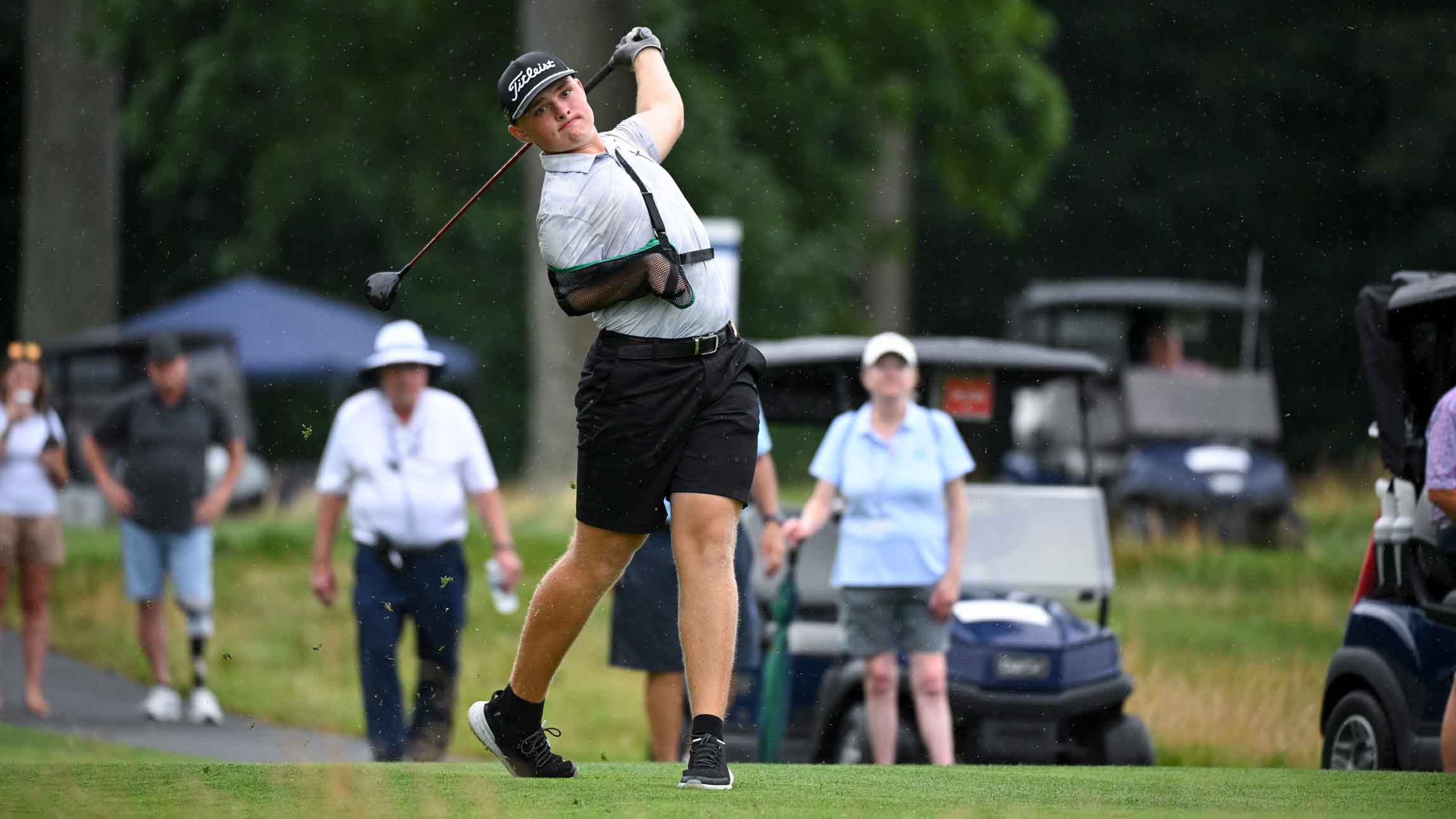

ROCKVILLE, Md. — Golf requires resilience.
It’s a pat refrain, easy to repeat without reflecting on its meaning, until true resilience greets you head on.
At Woodmont Country Club on Monday, the trait was evident everywhere you turned. (Hint: It involved more than just bouncing back from bogey).
The South Course at Woodmont is playing host this week to the 2025 U.S. Adaptive Open, the fourth installment of an annual event that has broadened golf’s umbrella while deepening public appreciation for the obstacles some players overcome.
This year’s championship has drawn a field of 96 golfers from 10 countries, the United States included, competing for trophies in eight categories of impairment, with overall men’s and women’s titles also on the line. The players range in age from 16 to 75 and employ swings that double as reminders of how many ways there are to get it in the hole.
“Great shot,” Andy Biser shouted after watching his son, Vince, blast his ball from a greenside bunker to tap-in range on the par-3 8th. The up-and-down kept Vince even for the day, not bad for a guy who swings with one arm and passed through hard-to-fathom trials to be playing golf at all.
Now 37, Vince was born with utero cerebral palsy and suffered a stroke in the womb that left him without full use of the right side of his body. His childhood was riddled with epileptic seizures so debilitating that, at age 16, he opted to undergo a hemispherectomy, a drastic surgery that severs the connection between two sides of the brain.
The procedure was “a miracle,” his father said. “It gave Vince his life back.”
It also freed him up to immerse himself in golf.
Playing from the left side with only his left hand on the club, Biser has whittled his handicap index to 3 and is a seven-time winner of the North American One-Armed Golfer Association Championship. This week, though, he’s been slotted in the “coordination impairment” category, a classification his family feels puts him at a competitive disadvantage against golfers who have use of both arms. The Bisers’ quibbles reflect a challenge in a relatively young sport populated by athletes with wide-ranging disabilities. Categorizing them is an imperfect science that can stand in the way of perfectly level playing fields.
“We’d like to see Vince in the one-armed division in this event, and we’ve petitioned for it,” Andy Biser said, as his son moved on to the 9th tee. “But then again, so much of this week is about camaraderie, and I know that he loves just being a part of it.”
Throughout Monday’s round, the first in a 54-hole event, it was muggy and buggy, with intermittent showers. But the mood was sunny among spectators and players alike.
“That sand sure is heavy,” Ryder Barr, a 16-year-old who is the youngest player in the field, said with a smile to a cluster of onlookers, having just smacked a mid-iron from a fairway bunker to the collar of the 11th green. He kept talking to the group on his march toward the green, with his mother, Megan, tagging close behind.
“That kid could make friends with a tree,” Megan said.

Ryder’s upbeat attitude, she said, has always been a marvel. It hardly wavered 10 years ago, when Ryder caught what appeared to be the common cold but turned out to be a rare viral affliction that attacked his spinal cord, leaving his right arm paralyzed. Barely was he out of the hospital when he told his parents that he wanted to get back to riding his bike. By 8th grade, he was playing five sports.
“At first, we worried he was going to hurt himself, but then we thought, What’s a broken arm?” Megan said. “That was something we all learned together. Anytime he’s wanted to do something, our attitude has been, we’ll figure it out.”
Lessons in perspective. Those were everywhere at Woodmont, too. Among the players in Ryder’s foursome was Nick Kimmel, a Marine Corps veteran who lost both legs and his left arm to an explosive while serving in Afghanistan in 2011. There had been dark moments since, but never regret or self-pity, his wife, Tracey said. She and Kimmel have two kids, Beck, 9, who walked beside her, and Finley, 1, who snoozed in a stroller as Tracey followed her husband around the course.
On the way to this year’s tournament, she said, Kimmel had stopped at Arlington cemetery to visit fallen comrades.
“He loves golf and he gets frustrated when he doesn’t play well,” Tracey said. “But he tells me, look, I’ve got nothing to complain about. I’ve got friends who didn’t make it home.”
If you were open to it, Monday’s action was an antidote for whatever ailed you — 96 golfers, no strangers to adversity, flanked by family, friends and fans, serving as a source of inspiration while seizing on a rare opportunity.
And if your vision was too narrow to take in the big picture, there was still a lot of fine golf to enjoy. Birdies came in bunches, plus a smattering eagles. By day’s end, nine players had finished under par. And a record had been set by the Englishman, Kipp Popert, who, competing in the same division as Vince Biser, posted a stunning 61 — the lowest single-round score in the four-year history of the event.
On the greens, golfers celebrated makes and groaned at misses. They rooted for each other but in crucial moments, they wore game faces. It was, after all, a competition. Every stroke counted.
As for how much each shot mattered in the grand scheme, that depended on your point of view.
The post ‘We’ll figure it out’: At U.S. Adaptive Open, lessons in perspective and resilience appeared first on Golf.